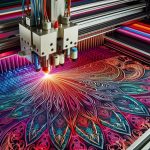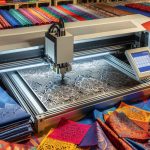Looking to make your fashion choices more sustainable?
Check out these 11 eco-friendly denim dyeing techniques that will revolutionize your wardrobe.
From natural indigo dyeing to plant-based dye extraction, these methods are both stylish and environmentally conscious.
Say goodbye to harmful chemical dyes and hello to fashion that cares about the planet.
With options like laser printing and waterless dyeing technologies, you can create a unique and sustainable denim look that’s sure to turn heads.
Table of Contents
Natural Indigo Dyeing
If you want to achieve a truly eco-friendly and sustainable denim dyeing technique, you should consider using natural indigo dye, which is frequently used by ethical fashion brands. Natural indigo dye is derived from the leaves of the indigofera plant through a process known as sustainable indigo extraction.
This extraction method involves natural indigo farming, where the indigofera plants are cultivated in a way that minimizes environmental impact. Natural indigo farming follows organic farming practices, avoiding the use of synthetic fertilizers and pesticides. This ensures that the indigofera plants are grown in a sustainable and environmentally friendly manner.
The leaves of the plants are then harvested and processed to extract the indigo pigment. Sustainable indigo extraction involves fermenting the indigofera leaves to release the indigo dye. This fermentation process is natural and doesn’t require the use of harmful chemicals. The extracted indigo dye is then used to dye denim fabric, creating a beautiful blue color that’s synonymous with denim.
By opting for natural indigo dyeing, you’re choosing a more sustainable and ethical approach to denim production. This technique not only reduces the environmental impact of dyeing, but it also supports farmers practicing natural indigo farming.
Plant-Based Dye Extraction
To continue the discussion on sustainable denim dyeing techniques, let’s explore the process of plant-based dye extraction. Plant-based dyeing techniques are gaining popularity in the fashion industry due to their eco-friendly nature. These techniques involve extracting dyes from various plants, such as indigo, madder root, and turmeric, to create vibrant and long-lasting colors for denim fabrics.
The process of plant-based dye extraction begins with the selection of the plant material. Plants rich in natural dyes, such as leaves, roots, or flowers, are chosen for their color properties. Once the plant material is collected, it undergoes a series of steps to extract the dye. This includes grinding or crushing the plant material to release the color pigments, followed by soaking or boiling it in water or other solvents to extract the dye.
One of the key advantages of plant-based dye extraction is its minimal impact on the environment. Unlike synthetic dyes, which often contain harmful chemicals and pollutants, plant-based dyes are biodegradable and non-toxic. Additionally, the use of plant-based dyes promotes sustainable agriculture practices, as it encourages the cultivation of dye-yielding plants.
Low-Impact Fiber Reactive Dyes
You can explore low-impact fiber reactive dyes as an eco-friendly option for denim dyeing. These dyes offer fast color absorption methods, allowing for quicker and more efficient dyeing processes.
Additionally, they promote reduced water consumption techniques, minimizing the environmental impact of denim production.
Fast Color Absorption Methods
In sustainable denim dyeing, utilizing fast color absorption methods with low-impact fiber reactive dyes is an effective way to achieve eco-friendly fashion. By adopting these techniques, you can contribute to a more sustainable and ethical fashion industry.
Here are three reasons why fast color absorption methods using low-impact fiber reactive dyes are beneficial:
-
Reduced water consumption: Fast color fixation techniques require less water during the dyeing process, leading to significant water savings.
-
Energy efficiency: These methods minimize the need for high-temperature dyeing, resulting in reduced energy consumption and lower carbon emissions.
-
Improved color fastness: Low-impact fiber reactive dyes have excellent color retention properties, ensuring that your denim retains its vibrant colors even after multiple washes.
Reduced Water Consumption Techniques
One effective approach for reducing water consumption in sustainable denim dyeing is through the implementation of techniques that utilize low-impact fiber reactive dyes. These eco-friendly dyeing methods are designed to minimize the environmental impact of the dyeing process while ensuring sustainable denim production.
Low-impact fiber reactive dyes are specifically formulated to require less water during application and rinsing, resulting in significant water savings compared to traditional dyeing methods. These dyes also have a higher affinity for cotton fibers, allowing for better color absorption and reduced dye wastage.
Eco-Print Techniques
Using eco-print techniques can significantly reduce the environmental impact of denim dyeing in fashion. These techniques offer a more sustainable approach to the dyeing process, minimizing the use of harmful chemicals and reducing water consumption. Here are three key benefits of eco-print techniques:
-
Eco print design: Eco-printing involves using natural elements, such as leaves, flowers, and other plant materials, to create unique patterns and designs on denim fabric. This eliminates the need for synthetic dyes and toxic chemicals, making it a more environmentally-friendly option.
-
Natural dye alternatives: Eco-print techniques often utilize natural dyes extracted from plants, roots, and even insects. These natural dye alternatives are biodegradable and don’t pose a threat to the environment. By opting for natural dyes, fashion brands can avoid the pollution caused by synthetic dye runoff.
-
Reduced water consumption: Eco-print techniques require less water compared to traditional dyeing methods. Instead of large amounts of water used for rinsing and washing, eco-printing often involves steaming or simmering the fabric with the natural dye materials. This not only conserves water but also reduces the energy required for heating.
Indigo Shibori Tie-Dye
To continue the discussion on sustainable denim dyeing techniques, let’s explore the process of Indigo Shibori Tie-Dye, which offers a unique and visually striking way to dye denim fabric while minimizing environmental impact.
Indigo Shibori Tie-Dye is a traditional Japanese dyeing technique that involves folding, twisting, or bunching fabric and then securing it with rubber bands or string before dyeing. The fabric is immersed in an indigo dye bath, resulting in a beautiful blue color.
The ice dyeing method is a variation of the traditional Shibori technique. Instead of using a dye bath, the fabric is covered with ice, and the indigo dye is sprinkled over it. As the ice melts, the dye is slowly absorbed by the fabric, creating a stunning marbled effect.
Indigo Shibori Tie-Dye is a sustainable dyeing technique because it uses natural indigo dye, which is derived from plants. Additionally, the folding and twisting techniques used in Shibori allow for precise control over the dyeing process, minimizing waste.
Ice Dyeing Method
Continuing from the previous subtopic on Indigo Shibori Tie-Dye, you can explore the Ice Dyeing Method as another sustainable denim dyeing technique that offers a visually stunning marbled effect.
Here are three reasons why ice dyeing techniques are gaining popularity in the fashion industry:
-
Unique Patterns: Ice dyeing creates beautiful, one-of-a-kind patterns on denim. As the ice melts, it blends with the dye, resulting in a mesmerizing marbled effect that can’t be replicated.
-
Eco-Friendly: Sustainability is a key concern in the fashion industry, and ice dyeing offers a more environmentally friendly approach. Unlike traditional dyeing methods that require large amounts of water and energy, ice dyeing uses minimal resources, making it a sustainable choice.
-
DIY Potential: Ice dyeing isn’t limited to professionals. It can be easily done at home, making it accessible for anyone interested in experimenting with denim dyeing techniques. With just a few simple materials and a willingness to get creative, you can create your own unique denim designs.
Kombucha Fermentation Dyeing
Let’s talk about the benefits of Kombucha Fermentation Dyeing. Kombucha dyeing is a sustainable technique that uses natural ingredients to create unique and eco-friendly colors for denim. By harnessing the power of fermentation, you can achieve beautiful hues while reducing the environmental impact of fashion.
The DIY process of Kombucha Fermentation Dyeing is something you can try at home. With just a few simple steps, you can create your own dye bath and experiment with different fabrics and colors. It’s a fun and creative way to add a personal touch to your clothing.
When compared to traditional dyeing methods, Kombucha Fermentation Dyeing stands out for its sustainability. Traditional dyeing often involves toxic chemicals and large amounts of water, which can harm the environment and contribute to pollution. In contrast, Kombucha dyeing uses natural ingredients and fermentation to create colors, making it a more eco-friendly option.
Benefits of Kombucha Dyeing
You can experience the benefits of kombucha dyeing, a sustainable denim dyeing technique that utilizes the fermentation process of kombucha. Here are three reasons why kombucha dyeing is a great choice for eco-friendly clothing options:
-
Environmentally Friendly: Kombucha dyeing uses natural dyes, which are derived from plant-based materials. Unlike synthetic dyes that can harm the environment and pollute water sources, natural dyes are biodegradable and non-toxic.
-
Reduced Water Usage: Kombucha dyeing requires less water compared to traditional dyeing methods. The fermentation process of kombucha allows the dye to penetrate the fabric more effectively, reducing the need for excessive water usage.
-
Unique Aesthetic: Kombucha dyeing creates a unique and organic look on denim. The fermentation process results in natural variations and patterns, giving each piece a one-of-a-kind appearance.
DIY Kombucha Dyeing Process
To begin the DIY kombucha dyeing process, you’ll need a few simple ingredients and materials. Kombucha dyeing is an eco-friendly technique that offers various benefits.
The organic acids and bacteria present in kombucha create a natural dye that’s safe for the environment and your skin. This fermentation process allows you to achieve unique and unpredictable colors on your fabrics.
To start, gather a glass jar, kombucha SCOBY (Symbiotic Culture of Bacteria and Yeast), tea bags, sugar, and a cotton fabric.
First, brew a strong black tea and add sugar to it. Once the tea cools, place it in the jar with the SCOBY and cover it with a cloth. Let it ferment for a week, stirring occasionally.
Afterward, strain the liquid and soak your fabric in it for a vibrant and sustainable dye.
Kombucha Dyeing Vs. Traditional Dyeing
Continuing the discussion from the previous subtopic, let’s explore the key differences between kombucha dyeing and traditional dyeing methods for a more sustainable denim dyeing process. Here are three important points to consider:
-
Kombucha dyeing benefits:
-
Natural and organic: Kombucha dye is made from fermented tea, making it a completely natural and eco-friendly alternative to chemical dyes.
-
Biodegradable: Kombucha dye is biodegradable, meaning it doesn’t contribute to water pollution or harm the environment.
-
Unique colors and effects: Kombucha dyeing can produce a range of interesting and one-of-a-kind color variations on denim, adding a unique touch to eco-friendly fashion.
-
Traditional dyeing drawbacks:
-
Chemical pollution: Traditional dyeing methods involve the use of toxic chemicals that can harm the environment and human health.
-
Water wastage: Traditional dyeing processes require large amounts of water, leading to significant water wastage and depletion of natural resources.
-
Energy-intensive: Traditional dyeing methods often involve high energy consumption, contributing to greenhouse gas emissions and climate change.
Upcycled Denim Dyeing
Using upcycled denim for dyeing is a sustainable practice that reduces waste in the fashion industry. Upcycled denim dyeing involves reusing old denim garments and repurposing them to create new and vibrant colors. Instead of discarding old jeans or denim scraps, these materials are given a new lease of life through the dyeing process.
Sustainable denim repurposing is an innovative way to minimize the environmental impact of the fashion industry. By using upcycled denim, you’re contributing to the reduction of textile waste and the conservation of resources. This practice not only helps to reduce the demand for new denim production but also extends the lifespan of existing denim garments.
The process of upcycled denim dyeing involves treating the fabric with natural dyes or eco-friendly dyeing techniques. Natural dyes can be derived from plants, fruits, or other organic sources, which are safer for the environment compared to traditional synthetic dyes. Eco-friendly dyeing techniques, such as low-impact dyeing or waterless dyeing, minimize water usage and chemical waste.
Upcycled denim dyeing not only promotes sustainability but also allows for creativity and individuality. By repurposing denim garments, you can create unique and personalized pieces that reflect your style and values.
Laser Printing on Denim
When it comes to sustainable denim dyeing techniques for eco-friendly fashion, a great option to consider is laser printing on denim. Laser printing offers several advantages over traditional dyeing methods, making it a popular choice among environmentally conscious fashion brands. Here are three reasons why laser printing on denim is a game-changer:
-
Laser distressing: Using a laser, intricate distressing patterns can be created on denim without the use of harmful chemicals or excessive water consumption. This technique allows for precise and customizable distressing, resulting in unique and visually appealing designs.
-
Laser engraving: Laser engraving on denim allows for the creation of intricate and detailed designs, such as logos or patterns, by etching the fabric’s surface. This technique offers a sustainable alternative to traditional printing methods, as it eliminates the need for additional chemicals and reduces water usage.
-
Reduced environmental impact: Laser printing on denim significantly reduces the environmental impact associated with traditional dyeing techniques. It eliminates the need for large amounts of water, harmful chemicals, and energy-intensive processes, making it a more sustainable option for eco-friendly fashion.
Waterless Dyeing Technologies
Waterless dyeing technologies offer several benefits over traditional dyeing methods. These include reducing water consumption and eliminating the need for harmful chemicals. By eliminating the use of water in the dyeing process, these technologies help to minimize environmental impact and promote sustainability in the fashion industry.
As the demand for eco-friendly fashion continues to grow, waterless dyeing technologies are poised to play a significant role in the future of sustainable dyeing.
Benefits of Waterless Dyeing
To achieve eco-friendly fashion, you can reap the benefits of waterless dyeing by incorporating waterless dyeing technologies into the denim dyeing process. Waterless dyeing techniques offer several advantages that make them a sustainable choice for the fashion industry:
-
Reduced water consumption: Waterless dyeing eliminates the need for large amounts of water typically used in traditional dyeing processes, reducing water consumption significantly.
-
Energy efficiency: Waterless dyeing technologies require less energy compared to traditional dyeing methods, contributing to lower carbon emissions and a smaller environmental footprint.
-
Chemical reduction: By using innovative dyeing technologies, waterless dyeing minimizes the use of chemicals, resulting in a reduction in the environmental impact of textile production.
Environmental Impact of Traditional Dyeing
By incorporating waterless dyeing technologies, you can significantly reduce the environmental impact of traditional dyeing methods. Traditional dyeing techniques often require large amounts of water, leading to water pollution and depletion of water resources. Additionally, the use of chemical dyes in traditional dyeing processes can release harmful substances into the environment, further contributing to pollution.
However, with the emergence of sustainability options and eco-conscious alternatives, it’s now possible to minimize these negative effects. Waterless dyeing technologies, such as air dyeing and foam dyeing, eliminate the need for excessive water usage and reduce chemical waste. These innovative techniques not only conserve water but also decrease energy consumption and greenhouse gas emissions.
Future of Sustainable Dyeing
With the development of sustainable dyeing techniques, the fashion industry can embrace a more environmentally-friendly future. Future innovations in dyeing technologies hold the promise of revolutionizing the way fabrics are colored, making the process more sustainable and reducing its impact on the environment.
Here are three exciting advancements that are shaping the future of sustainable dyeing:
-
Waterless dyeing technologies: These innovative techniques eliminate the need for excessive water usage, which is a major concern in traditional dyeing processes. By using alternative methods such as air or gas, waterless dyeing significantly reduces water consumption and eliminates the pollution caused by wastewater discharge.
-
Natural dye sources: As sustainable practices gain momentum, there’s an increasing focus on using natural dye sources derived from plants, insects, and minerals. These sources offer a renewable and eco-friendly alternative to synthetic dyes, reducing the environmental impact of the dyeing process.
-
Digital printing: Digital printing technology allows for precise and efficient color application, minimizing waste and reducing the need for excess dyeing chemicals. This method also enables customization and on-demand production, further promoting sustainability in the fashion industry.
As the fashion industry continues to prioritize sustainability, future innovations in dyeing techniques hold great potential in transforming the industry’s practices and paving the way for a more eco-friendly future.
Ozone Denim Bleaching
Save water and reduce chemical usage by adopting ozone denim bleaching for a more sustainable and eco-friendly approach to dyeing. Ozone denim bleaching is an alternative to traditional denim bleaching techniques that often involve harmful chemicals and excessive water consumption. By utilizing ozone gas, this innovative technique not only reduces water usage but also eliminates the need for toxic chemicals, making it a more environmentally friendly option.
The process of ozone denim bleaching involves exposing denim fabric to ozone gas in a controlled environment. Ozone has powerful oxidizing properties, which allows it to effectively break down indigo dye molecules, resulting in a bleached effect on the fabric. This technique offers several advantages over conventional methods:
-
Water savings: Ozone denim bleaching significantly reduces water consumption compared to traditional bleaching techniques. It eliminates the need for multiple rinsing cycles, leading to substantial water savings.
-
Chemical reduction: Ozone gas is a natural oxidizing agent, eliminating the need for harsh chemicals such as chlorine or potassium permanganate. This reduces the environmental impact of the bleaching process.
-
Energy efficiency: Ozone denim bleaching requires less energy compared to conventional methods. It operates at lower temperatures and shorter processing times, resulting in energy savings.
-
Improved worker safety: By eliminating the use of toxic chemicals, ozone denim bleaching provides a safer working environment for textile workers.
-
Quality preservation: Ozone denim bleaching maintains the quality and strength of the fabric, ensuring that the denim retains its durability and longevity.
Frequently Asked Questions
How Long Does the Natural Indigo Dyeing Process Take?
The natural indigo dyeing process for denim takes around 5-7 days. Its benefits include a vibrant color, longer-lasting dye, and less environmental impact compared to synthetic dyes.
What Are the Most Common Plant-Based Materials Used for Dye Extraction?
The most common plant-based materials used for dye extraction in sustainable dyeing methods are indigo, madder root, and cochineal. Using these natural dyes has several benefits, including reducing environmental impact and promoting eco-friendly fashion.
Are Low-Impact Fiber Reactive Dyes Suitable for All Types of Denim?
Yes, low-impact fiber reactive dyes are suitable for all types of denim. They are eco-friendly and can be used in various denim dyeing techniques, resulting in sustainable and fashionable denim products.
How Can Eco-Print Techniques Be Used to Create Unique Patterns on Denim?
To create unique patterns on denim using eco-print techniques, you can explore botanical imprints and natural pigment dyeing techniques. These methods allow you to infuse your denim with nature-inspired designs, making them truly one-of-a-kind.
What Is the Difference Between Indigo Shibori Tie-Dye and Traditional Tie-Dye Methods?
Indigo shibori tie-dye and traditional tie-dye methods have a difference. Indigo shibori tie-dye uses indigo dye and specific folding and binding techniques to create unique patterns, while traditional tie-dye uses various dyes and tying methods.
- Innovations in Moisture-Wicking Textiles - July 18, 2024
- Engineering Fabrics for Optimal Performance - July 18, 2024
- The Science of Breathability in Fabrics - July 18, 2024







